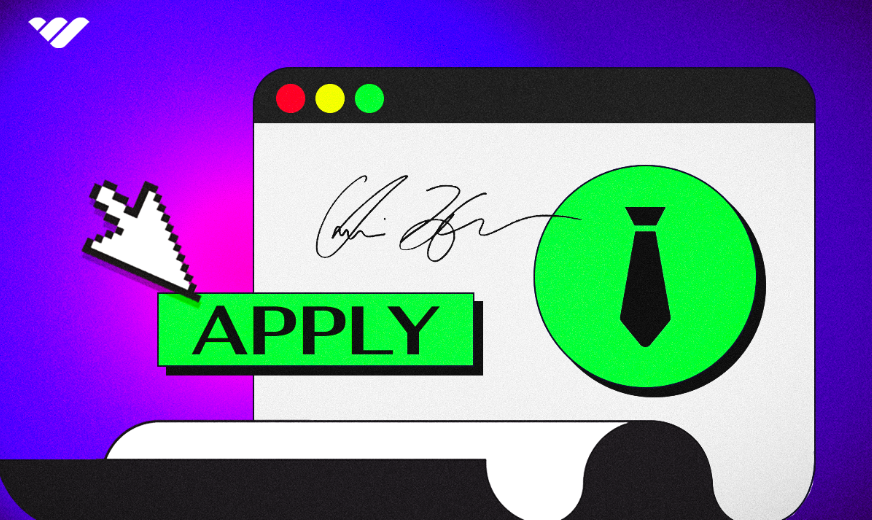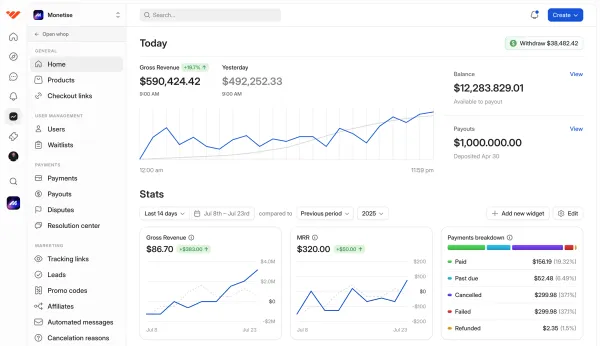Explore dozens of types of online jobs, from freelance gigs to remote roles. Learn where to find them and how to start earning with Whop online now.
Key takeaways
- Digital product sellers can earn $100-$1,000+ monthly with high-profit margins and minimal startup capital.
- Amazon FBA sellers access 300+ million users but face high service fees that impact profitability.
- Social media managers earn $37,000-$60,000 annually helping businesses grow their online presence.
- Print-on-demand designers create products without inventory, earning $100-$10,000+ monthly through commission sales.
- Remote sales closers average $112,891 annually by closing high-ticket offers through virtual calls.
If you’ve landed on this article, then you’re serious about working online.
Maybe you’re tired of the daily commute, want to spend more time with your family or need a side hustle to boost your income. Or perhaps, you just crave the freedom to work from anywhere—your favorite coffee shop, your couch, or even a beachside cabana.
Whatever your reason, you’re not alone.
More and more people are turning to online jobs as a way to build careers that fit their lives, not the other way around.
But with so many options out there, figuring out where to start can feel overwhelming.
That’s why we’ve put together this guide—to help you explore 30 types of online jobs and where to find them.
Wherever your passions, strengths, or interests lie, we’ve got an online job that’s perfect for you.
Let's start with ecommerce.
Online ecommerce jobs

1. Digital product seller
Selling digital products is one of the best ways to earn money online. It has high-profit margins and requires little to no capital to get started.
You can sell digital products like ebooks, courses, templates, printables, and even software. The beauty of this is that once the product is created, you can sell it multiple times to people around the world without worrying about inventory and shipping logistics.
That said, it does take some time and effort.
You’ll need to spend time creating products that solve real problems for your audience and marketing these products via a website, social media, or newsletter.
How to get started: Whop makes it super easy to get started with selling digital products—create a whop, upload your digital products, set your price (whether it’s a one-time or recurring fee), and promote them on social media.
Average earnings: For starters, you can earn anywhere from $100 - $1,000+ per month. You can easily scale this to $10,000+ as you refine your product and build an engaged following across multiple marketing channels.
2. Dropshipper
Dropshipping is basically selling products directly to customers without holding any inventory. So when a customer places an order, you forward it to your supplier, who then ships the product directly to your customer.
Popular dropshipping categories include beauty, pet products, technology, kids’ items, gifts, photography gear, and fitness equipment.
Starting a dropshipping business doesn’t mean it’s free—it simply reduces the cost of inventory. You’ll still need to invest in your online store platform and paid ads.
How to get started: Choose a niche and source products from suppliers on platforms like AliExpress, Spocket, or CJ Dropshipping. Build your store on Shopify or WooCommerce, list your products with clear images and detailed descriptions, and use free or paid marketing to drive sales.
Average earnings: Beginner dropshippers make between $100 and $1,000 per month. If you stick with it and gain more experience under your belt, you could earn between $10,000 to $100,000+ per month.
3. Amazon FBA seller
As an Amazon FBA (Fulfillment by Amazon) seller, you get to sell your physical products on the Amazon platform and gain exposure to its 300 million+ active user base.
Unlike dropshipping, where you don’t hold any inventory, Amazon FBA requires you to purchase products in bulk upfront and ship them to Amazon’s fulfillment centers. From there, Amazon takes care of storage, packing, shipping, and customer service.
While this frees up time to focus on other areas of your business, Amazon FBA comes with high service fees, which you’ll need to manage to ensure profitability.
How to get started: Create an Amazon seller account and join the FBA program. Search for wholesalers on platforms like Alibaba and order samples to confirm product quality. Once satisfied, purchase in bulk, ship the items to Amazon FBA centers, and list your products for sale.
Average earnings: Half of Amazon sellers earn between $100 and $5,000 per month, while the top 5% make between $50,000 and $500,000 monthly.
4. Thrifter
As a thrifter, you can turn your love for finding unique, secondhand items into a profitable online business—buy quality thrifted items, market them, and sell them at a higher price.
Popular product categories include branded clothing, jewelry, sporting equipment, furniture, portrait paintings, and house decor.
To increase your chances of success, start with a product category you’re familiar with and passionate about.
How to get started: Source thrifted items from your home, local thrift stores, or garage sales. Once you've gathered your inventory, list them for sale on platforms such as eBay, Poshmark, Depop, Craigslist, and Facebook Marketplace.
Average earnings: Part-timers earn anywhere from a few hundred dollars to $5,000 per month. Full-timers make about $5,000 to $10,000 per month.
- Reselling clothes 101: How to make money thrifting
- Success story: Entrepreneur quits his finance job to thrift with Whop
5. Handmade product seller
If you enjoy making DIY jewelry, candles, pottery, stickers, or custom artwork, becoming a handmade product seller is a great way to monetize your creativity.
Being successful in this field isn’t only about crafting—it’s also about presentation and marketing. You have to take eye-catching product photos and write engaging descriptions about what makes your items unique.
How to get started: Identify the type of product you want to create and design a collection of at least three items. List them on Etsy and optimize your descriptions for Etsy search. You can also work on getting more traffic from social media and paid ads.
Average earnings: According to Topbubbleindex, Etsy sellers make between $43K and $46K annually, while top earners make over $65K monthly.
6. Print-on-demand designer
As a print-on-demand (POD) designer, you get to turn your designs into actual products without dealing with inventory or shipping.
POD platforms like Redbubble, Printful, and Zazzle make this possible. They let you upload your designs and place them on everyday items like t-shirts, mugs, tote bags, bottles, and phone cases.
So when a customer goes to these platforms and purchases an item with your design, the POD platform prints it, ships it, and pays you a commission for the sale.
How to get started: First, use tools like Canva and Adobe Illustrator to create your designs. Then, upload them to a POD platform of your choice and place them on the products you want to sell.
Average earnings: Beginners can expect to make $100 to $1,000 monthly. Top earners who have nailed their niche and marketing earn over $10,000 monthly.
Marketing and sales jobs

7. Social media manager
Businesses know social media is great for reaching their audience, but managing it alongside other tasks can be overwhelming. This is where you come in as a social media manager.
You can help these businesses grow their social media presence across platforms like Facebook, X, LinkedIn, Instagram, and TikTok.
This involves developing a social media strategy, creating and scheduling posts, engaging with followers, and analyzing performance metrics.
How to get started: Take free or paid digital marketing courses, build a portfolio with personal or volunteer projects, and apply to job boards and freelance platforms. You can also pitch your services directly to businesses you'd like to work with.
Average earnings: Social media managers make between $37,000 to $60,000 annually.
- How to become a social media manager
- Digital marketing salary: How much can you earn as a digital marketer
8. Digital ads manager
Being a digital ads manager means you help businesses run successful online ad campaigns.
Your job involves understanding your clients' target audience, products, and goals, and developing ad strategies for platforms like Google Ads, Facebook Ads, and Instagram Ads.
Then you’ll set up the campaigns, monitor, and optimize them to maximize traffic, conversions, and sales.
How to get started: Take online courses in digital advertising, copywriting, and graphic design. Pick an industry you’re interested in, like fashion or beauty, and build a portfolio by creating ads for family, friends, or local businesses. Then, apply to job boards and pitch your services to clients.
Average earnings: In the USA, you can earn between $37,000 to $100,000 per year.
9. Lead generation specialist
Lead generation specialists help businesses find and qualify potential customers.
In this role, you’ll research your clients’ inbound and outbound leads via their websites and social profiles. Using a structured framework, you’ll determine if the leads are a good fit, record accurate information about them in your clients’ CRM software, and pass qualified leads to the sales team for further engagement.
In some cases, you may also assist the sales team with follow-ups, product demos, and maintaining relationships after prospects become customers.
How to get started: A bachelor's degree in marketing or sales can help, but it’s not necessary. Focus on improving your research and communication skills, and learn CRM tools like HubSpot and Salesforce to strengthen your CV before applying for jobs.
Average earnings: According to Glassdoor, this could range from $58,000 to $97,000 annually.
10. Sales funnel specialist
You’ll be working with businesses to optimize their sales funnels for higher conversions and sales.
This means collaborating with different marketing teams—content, email, social media, and ads—to understand and optimize conversion paths.
Plus, you’ll be in charge of A/B testing website CTAs, landing pages, and lead-generating forms to find out which structures and formats make your clients the most money.
How to get started: Volunteer to help businesses improve their sales funnels, document your work and results, and use them to build your portfolio. Adding testimonials from these clients will make your portfolio even stronger.
Average earnings: ZipRecruiter says you can earn an average of $66,067 annually as a sales specialist, but this could go up to $119,000/year.
11. Remote sales closer
As a remote sales closer, your job is to help businesses sell high-ticket offers by closing sales virtually through email, social media DMs, audio, or video calls.
This means you should be able to conduct product demos, answer prospects’ questions, handle objections, and persuade them to make a purchase.
Depending on the client, you’ll either work closely with a lead generation specialist who will connect you with your clients’ leads or you might take on their role as well.
How to get started: Learn persuasive sales techniques through books, podcasts, YouTube, and online courses. Pick an industry like real estate, finance, or tech, and work with a few businesses for free (or low rates) to gain experience and build your portfolio.
Average earnings: ZipRecruiter reports you can earn an average of $112,891 annually.
- Success story: From 0 to 100(k) in 27 days—meet remote closer Alexis Seleste
- What is a high-ticket offer and why you should create one
Online tech jobs

12. Software tester
Do you enjoy breaking things to make them better? Software testing might be the perfect fit for you.
In this role, you’ll ensure that web, desktop, or mobile applications work perfectly—by running manual tests, which involve using the software like an end user to spot bugs, and automated tests, where you use tools to simulate user actions and check for errors.
After these tests, you’ll document any issues and work with developers to fix them, ensuring the application is ready for release.
How to get started: While many software testers have a computer science degree, it's not the only path. Take a course like ISTQB, get certified, join a boot camp to gain hands-on experience, and apply for entry-level jobs on job boards.
Average earnings: Software testers make between $65,000 and $117,000 annually, according to Glassdoor.
13. Data analyst
These days, businesses are flooded with data from their various departments but struggle to make sense of it for decision-making. This is where data analysts come in.
As a data analyst, your job is to turn raw data into meaningful insights that help companies make smart decisions.
This means pulling data from different sources like spreadsheets and databases, analyzing it with statistical techniques, and creating visuals to highlight trends and patterns.
How to get started: Develop basic data analysis skills, like statistics, and use analysis tools like Excel or Power BI. Take a course or boot camp to learn tools like SQL, Python, or R. Create a project portfolio and begin applying for jobs.
Average earnings: Indeed reports that data analysts make an average of $80,875 per year.
14. UI/UX Designer
A UI/UX designer's role is to create user-friendly and visually appealing interfaces for software products, so end users find it easy to navigate and use.
As a UI/UX designer, you'll gather user requirements to understand their needs and behaviors and use tools like storyboards to illustrate how users will interact with the software.
Finally, you’ll develop the UI mockups and pass them on to the developer team for implementation.
How to get started: Learn design basics through online courses and tutorials. Get comfortable with tools like Figma, Adobe XD, or Sketch, and practice by creating mock projects or redesigning apps and websites.
Average earnings: UI/UX designers earn an annual base pay between $66,000 and $112,000, according to Glassdoor.
15. Product manager
Behind every successful product is a product manager orchestrating its journey from concept to completion.
In this role, you guide teams through planning, designing, developing, and launching products that meet both user needs and business objectives.
You’ll need strong communication and organizational skills, along with how to use tools like Trello, Jira, or Asana to keep projects on track.
How to get started: Learn about product management and development concepts from books, podcasts, and courses. Earn a certification from a reputable source to boost your resume and start applying for jobs.
Average earnings: The average salary of remote product managers is $159,405/year, per what ZipRecruiter reports.
16. Software developer
Software developers design and build the web, mobile, and desktop applications that we use on a daily basis. Your primary responsibilities include writing, testing, and maintaining code that meets user needs.
You’ll also need soft skills like effective communication to collaborate with team members and stakeholders, problem-solving to address technical challenges, adaptability to learn new tools and technologies, and time management to meet project deadlines.
How to get started: If you’re not looking to pursue a computer science degree, start with free courses like Havard’s CS50 course, which is an introduction to computer science. Then join boot camps, attend hackathons, work on personal projects, and store them on GitHub. Finally, start applying for entry-level jobs.
Average earnings: Glassdoor says software developers make between $84,000 and $128,000 as base pay.
Online writing jobs

17. Content writer
Content writers help businesses connect with their audience with educational, inspirational, or entertaining content pieces, mainly blog posts and emails.
Your job involves researching topics, writing in a simple and clear style, and checking for grammar and spelling errors to keep your content polished.
You’ll need to be comfortable with using tools like Trello and Notion to manage your content projects and Grammarly to catch grammar and spelling errors.
How to get started: Choose a niche (e.g., travel, fashion, finance, or software), study top writers in that field, create portfolio samples and apply for content writer roles.
Average earnings: Content writers earn $46,000 to $83,000 as base pay annually.
18. Content editor
Every polished piece of writing owes its quality to a skilled content editor.
After a content writer completes a piece, you’ll come in to check for grammar, spelling, and punctuation errors, refine sentence structure, and make sure the content follows a specific tone and style.
If you’re part of a content marketing team, your responsibilities may extend to developing content strategies, writing project briefs, managing writers, and collaborating with graphic designers to create accompanying visuals for articles.
How to get started: Publish your work on your website or other reputable sites, then apply for content editing jobs with online magazines, publications, or marketing teams. You may need to begin as a content writer and progress to an editor role.
Average earnings: Editors earn a base pay between $42,000 and $71,000 yearly.
19. Proofreader
After a content editor works on content pieces, a proofreader reads through it a final time to correct any grammar, spelling, and punctuation errors.
Unlike the editor, they don’t make any major edits to a content’s structure or have to go back and forth with another writer or editor.
Their focus is to peruse content pieces with an eagle eye and ensure the content is error-free for publication, so it meets professional standards and is polished to perfection.
How to get started: Offer to proofread sample work for free to build your portfolio and gather testimonials. Then start applying for jobs at publishing companies and agencies.
Average earnings: Proofreaders in the USA earn an average hourly wage of $27.65/hour.
20. Translator
Translators turn written content from one language into another while keeping its meaning, tone, and cultural nuances accurate. They work on a variety of content types like articles, books, and marketing materials.
To do this job, you’ll need fluency in at least two languages and good writing skills. You may also choose to specialize in a specific field, like financial, legal, literary, technology, or medical.
How to get started: Immerse yourself in the language you want to learn through courses, podcasts, movies, or by visiting a country where it’s spoken. Then apply for in-house positions at companies or agencies or go the freelance route.
Average earnings: According to Indeed, translators earn an average of $69,895/year.
Online graphic design jobs

21. YouTube thumbnail designer
YouTubers understand that a great thumbnail can make or break their video’s success.
As a thumbnail designer, your job is to help YouTubers improve their channel’s overall performance with thumbnails that grab attention and encourage viewers to click.
When working with specific clients, you need to ensure that your designs align with what works in their niche as well as their brand.
How to get started: Study the successful thumbnail designs and use tools like Canva or Adobe Photoshop to create sample thumbnails for your portfolio. Then, pitch your services to YouTubers via email or social media.
Average earnings: For starters, you can make between $10 and $30 per thumbnail design. As you gain experience you can charge anywhere from $30 to $100+ per thumbnail.
22. Presentation designer
Formal presentations have a bad rep of being dull and boring, but as a presentation designer, you’re paid to change that.
Your job is to transform ideas and data into visually engaging slides that tell a story and hold the audience’s attention. You’ll work on organizing content into a logical flow, selecting fonts, graphics, and layouts, and ensuring the style matches the presentation’s purpose.
Collaboration with clients is key to making sure the final design meets their goals and connects with their audience.
How to get started: Learn how to use presentation tools like Microsoft PowerPoint, Google Slides, and Keynote with free YouTube tutorials. Create mock presentations for practice and your portfolio, and start applying to job boards.
Average earnings: Depending on your experience level, you can charge between $20 to $100+/hour as a freelance presentation designer.
23. Motion graphics designer
Motion graphics bring static designs to life, and as a motion graphics designer, you’ll create animations that make designs more engaging and memorable.
These include logo animations, explainer videos, social media graphics, and animated infographics. This requires effective communication with key stakeholders, creativity, and how to use relevant software to get the job done.
How to get started: Learn how to use relevant software like Adobe Photoshop and Illustrator, build sample projects for your portfolio, and apply to jobs at design companies and agencies.
Average earnings: A motion graphic designer makes an average of $75,625/year.
Online education jobs

24. Language teacher
If you’re confident in your English skills (or other native language) and you enjoy teaching, becoming an online language teacher could be a great fit.
You’ll help students improve their grammar, vocabulary, pronunciation, and conversational skills through one-on-one or group lessons. Unlike traditional teaching, you can set your own hours or rates, and work from the comfort of your home.
How to get started: Create an account on a language learning platform like italki or Preply. If you’re just getting started, promote your service via social media to increase your chances of connecting with students faster.
Average earnings: According to ZipRecruiter, language teachers earn an average of $23/hour.
25. Skills instructor
What if you could turn a skill you have into a job that pays the bills?
That’s exactly what you can do as a skills instructor—where you can teach others to improve any skill at all: dance, cooking, makeup, piano, guitar, crochet, coding, photography…the possibilities are endless.
All you need is a solid understanding of the skill, the ability to explain it clearly, and a structured approach to teaching. You should also be able to provide practical exercises and offer constructive feedback to help your students progress.
How to get started: Choose the skill you want to teach and promote it on social media with demo videos and learning tips. Invite people to contact you for one-on-one lessons.
Average earnings: Skills instructors earn anywhere from $20/hour to $100+/hour, depending on the complexity of the skill and their experience level.
26. LMS administrator
An LMS (Learning Management System) administrator manages the operation of online learning platforms for schools, businesses, or training organizations.
This includes customizing the platform to fit client needs, enrolling users, managing user accounts, setting up courses, and troubleshooting any issues that arise on the platform.
You’re also in charge of monitoring the LMS platform’s performance and implementing updates to ensure it runs smoothly at all times.
How to get started: Learn basic project management skills and how to work with major LMS platforms like Moodle, Canvas, and Blackboard, and earn certifications to boost your resume.
Average earnings: Glassdoor says LMS admins earn $69,849 per year on average.
Other online jobs

27. Virtual assistant
As a virtual assistant (VA), your job is to help entrepreneurs and busy professionals with simple tasks like managing emails, scheduling appointments, updating social media, and taking meeting minutes.
To excel in this role, you’ll need good organization and communication skills, an eye for detail, and the ability to stay on top of things without much supervision.
Knowing how to use productivity software like Google Workspace, Microsoft Office, and Trello will also come in handy.
How to get started: Work with a few family and friends for free to gain experience and gather testimonials. Then apply to job boards and promote your services on social media platforms like LinkedIn and X.
Average earnings: VAs earn an average hourly rate of $27.10, according to Indeed.
28. Community manager
Community managers are responsible for managing a business’s online community, which could be hosted on platforms like Discord, Slack, Facebook, or Telegram.
You’ll be responsible for publishing engaging content in the community, responding to questions, moderating discussions, and analyzing the community’s engagement levels over time.
Depending on the business, this role may extend to engaging with their audience across all social platforms.
How to get started: Build a small community project on your own or volunteer to help a business run their community for free. Use these to build your portfolio and start pitching your services to other businesses.
Average earnings: Indeed reports an average yearly salary of $60,038 for community managers.
29. Social media influencer
Creating engaging content and building a loyal audience online is at the heart of being a social media influencer.
You share posts, videos, and stories on platforms like Instagram, TikTok, or YouTube, focusing on topics like fashion, fitness, travel, or tech.
When you’ve built an engaged following, you can start collaborating with brands for sponsored posts on your page.
How to get started: For starters, choose one social media platform where your target audience is most active. Post consistently on there to grow your audience, then reach out to brands for collaborations. You can also join influencer marketing platforms like Aspire or Upfluence to find relevant opportunities.
Average earnings: ZipRecruiter says social media influencers make an average of $57,928/year.
- How to become a travel influencer and earn money from anywhere
- The ultimate guide to becoming a successful influencer
- How to make money as an Amazon Influencer: Everything you need to know
30. Bookkeeper
If you’re organized and good with numbers, working as a freelance bookkeeper might be a great fit for you.
Bookkeepers are responsible for tracking income and expenses, reconciling accounts, processing invoices, and preparing financial reports to help businesses stay on top of their finances.
How to get started: Enroll in an accounting course and get certification. Also, get certified in using a bookkeeping software like QuickBooks. Then start applying to jobs and reaching out to businesses who might need your services.
Average earnings: Glassdoor reports that virtual bookkeepers earn an average of $44,000 to $67,000 annually as base pay.
Where to find online jobs
There are many channels for finding online job opportunities. Here are some of the best places to start your search:
1. Freelance platforms
Freelance platforms like Fiverr and Upwork are great for both beginners and experienced freelancers. These websites let you create a profile, showcase your skills, and bid on projects that match your expertise.
2. Job boards
Job boards are a great starting point for finding remote jobs and freelance opportunities. General job boards like LinkedIn Jobs, Indeed, Glassdoor, and Wellfound offer a variety of roles across industries.
You can also check to see if there are niche job boards for your chosen field. For example, ProBlogger, Peak Freelancer, and Superpath are perfect places for finding freelance writing roles.
3. Cold pitches
Sometimes the best jobs aren’t advertised on job boards and freelance platforms. So research businesses that may need your skills and send personalized pitches (via email or social media DMs) explaining how you can help them.
These pitches are “cold” because this is the first time the recipient is hearing about you. For example, if you’re looking to be a freelance writer, you could pitch to SaaS companies who don’t know who you are but may need your writing services to help grow their blog.
4. Social media
Social media platforms like LinkedIn and X (formerly Twitter) are goldmines for online job opportunities.
To score these opportunities, start by updating your profile to highlight your skills. Post content that showcases your expertise and engage with other professionals to expand your network and visibility.
In addition to this, identify potential clients by researching and connecting with them. Pay attention to their posts, engage with their content, and learn about their needs. Offer help wherever you can to build trust before asking if they could use your services.
5. Reddit forums
Subreddits like r/hireawriter, r/remotework, r/digitalnomad, and many others are excellent spaces for finding remote job opportunities, promoting your freelance services, and connecting with clients for your online business.
When you identify the subreddits relevant to your work, visit them regularly to look for job postings or client requests. Also, engage with the community by leaving thoughtful comments on posts to share your knowledge and build credibility.
If the subreddit allows, create your own posts to highlight your services and connect with people who may need them.
6. Newsletters
There are niche newsletters that curate remote job listings and deliver them straight to your inbox. Subscribing to these can save you the time and energy you’d spend scouring the internet for online job opportunities.
Social media is a great resource for finding niche newsletters. So follow professionals in your industry on platforms like LinkedIn and X, as they’re most likely to share the best newsletter recommendations.
7. Existing network
Don’t overlook your personal connections. Reach out to family, friends, ex-bosses, and ex-colleagues. They might know of some remote opportunities or be able to recommend you to someone in their network.
Find more legit online jobs in this guide.
Make money online with Whop
So there you have it, a list of the best online jobs that’ll help you quit your traditional 9-5 job and work from anywhere you want.
If you have any knowledge or skills from school, work, or hobbies, you can package them into digital products to make money. No skill or knowledge is too simple to share—what comes easily to you might be exactly what others are willing to pay for!
Whop makes it easy to get started.
With a Whop account, you can sell courses, downloadable files, software, community access, coaching, newsletters, webinars, and more.
You can set a one-time fee, offer subscriptions, or even let customers pay in installments. Whop handles the product delivery and payment processing, so you can focus on creating multiple products to scale your income.
It’s completely free to get started - Whop's fees start as low as 2.7% + $0.30 cut on each sale.
So, if you’re ready to turn your knowledge and skills into income while working online, sign up for a free Whop account today!







![80 remote side hustles to make money from anywhere [2026]](/blog/content/images/size/w1000/2025/11/tablet-designer-home-opt.webp)







